Opisthoteuthis agassizii
Roger Villanueva, Michael Vecchione, and Richard E. YoungIntroduction
O. agassizii is the type species of the genus and was described from a single specimen. Verrill did not describe the shell as he mistook the fin cartilage for the shell. This mistake later caused Berry to establish a new subgenus for species with "typical" shells. O. agassizii has recently been redescribed (Villanueva et al., 2003). Maximum known size is 63 mm ML (males) and 56 mm ML (females) (Villanueva et al., 2003).
Characteristics
- Arms
- Arms subequal in length (283-332% of ML)
- Mature animals with 58-80 suckers/arm.
- Mature males: Proximal and distal fields with markedly enlarged suckers on all arms. Proximal field with suckers 6-10 usually enlarged, suckers 7-8 usually largest; suckers of all arms equally enlarged. Distal field with 7 or 8 enlarged suckers beginning at sucker 30-33; suckers 34,35 or 36 usually largest; enlargement greatest on arms IV, moderate on arms II and III, least on arms I. Sucker size in distal field exceeds that of proximal field only in large males.
- Mature females: Comparable proximal field with slightly enlarged suckers.
- Series of web supports present on ventral margins of arms beginning from sucker 26-32 to sucker 50-53.
- First cirri between suckers 3 and 4 (rarely between 2 and 5.
- Longest cirri 1.7-5.0 mm (4-9% of ML).
 Click on an image to view larger version & data in a new window
Click on an image to view larger version & data in a new window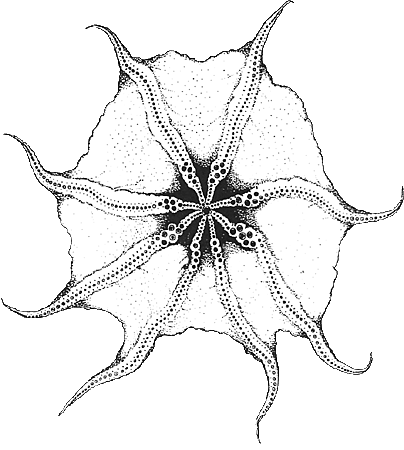
Figure. Oral view of arms and web of O. agassizii, neotype. Drawing from Villanueva, et al. (2002).
Comments
The above description was taken from Villaneueva et al., in press. More details of the description of Opisthoteuthis agassizii can be found here.
Villaneueva et al. (in press) found that the shell showed considerable variation which was somewhat related to sexual maturity. Some shells had type A (see "can be found here" above). However the distinctness of the shelf and the height and thickness of the shoulder varied: when the shoulder was low the spike was long and when the shoulder was high the spike was short. Other shells had a type B. The latter condition was more common in mature animals.
O. agassizii shares (where males are known) enlarged suckers in both proximal and distal fields that are the same on all arms with O. bruuni, O. chathamensis, O. grimaldii and O. sp. H. It differs from O. bruuni in the number of suckers in the distal field (7-8 vs 2-3) and in the form of the funnel organ (V-shape vs 2 pads), it differs from O. chathamensis in having more suckers on each arm (58-80 vs 41-45) and a unilobular digestive gland, it differs from O. sp. H in having web supports and it differs from O. grimaldii in having a unilobular digestive gland and multiple web supports.
Life History
Males mature about 22 mm ML and females at about 23 mm ML. Mature eggs from oviducts measure 7.7 x 5.8 mm to 10.2 x 7.7 mm. A mature female (54 mm ML) had 320 oocytes in ovary. (Villaneueva et al., 2003.)
Distribution
The type locality: Off Grenada, Lesser Antilles, tropical Western North Atlantic, 535 m. Species known from the western North Atlantic including the Gulf of Mexico, the Caribbean, the Bahamas and along the east coast of the USA to about 40° N. Captures came from depths of 227 to 1935 m. In DeSoto Canyon, northeastern Gulf of Mexico, peak catches (total catch was 46) came from depths of 732 - 914 m (Villaneueva, et al., 2003.)
References
Villanueva, R., Collins, M., Sanchez, P. and N. Voss. 2002. Systematics, distribution and biology of the cirrate octopods of the genus Opisthoteuthis (Mollusca, Cephalopoda) in the Atlantic Ocean, with description of two new species. Bulletin of Marine Science 71(2):933-985.
Title Illustrations

| Scientific Name | Opisthoteuthis agassizii |
|---|---|
| Reference | Villanueva, R., Collins, M., Sanchez, P. and N. Voss. 2002. Systematics, distribution and biology of the cirrate octopods of the genus Opisthoteuthis (Mollusca, Cephalopoda) in the Atlantic Ocean, with description of two new species. Bulletin of Marine Science 71(2):933–985. |
| Sex | Male |
| Life Cycle Stage | mature |
| Size | 42 mm ML |
| Type | Neotype |
| Copyright | © 2002 Bulletin of Marine Science |
About This Page
Roger Villanueva

Instituto de Ciencias del Mar (CSIC), Barcelona, Spain
Michael Vecchione

National Museum of Natural History, Washington, D. C. , USA
Richard E. Young

University of Hawaii, Honolulu, HI, USA
Page copyright © 2016 Roger Villanueva , Michael Vecchione , and Richard E. Young
All Rights Reserved.
- First online 13 May 2003
Citing this page:
Villanueva, Roger, Michael Vecchione, and Richard E. Young. 2003. Opisthoteuthis agassizii . Version 13 May 2003 (under construction). http://tolweb.org/Opisthoteuthis_agassizii/20151/2003.05.13 in The Tree of Life Web Project, http://tolweb.org/




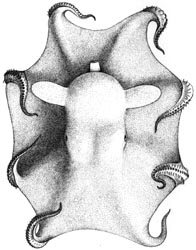
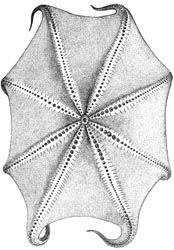
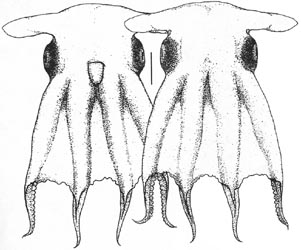
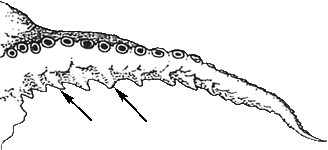


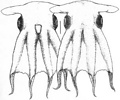


 Go to quick links
Go to quick search
Go to navigation for this section of the ToL site
Go to detailed links for the ToL site
Go to quick links
Go to quick search
Go to navigation for this section of the ToL site
Go to detailed links for the ToL site